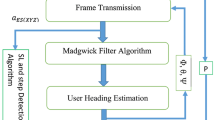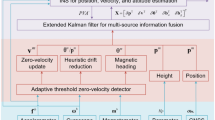Abstract
The world is adopting complete wireless infrastructure to cover small size buildings as well as large geographical regions. Indoor Positioning System (IPS) is used to locate stationary as well as non-stationary objects in the wireless domain. The indoor localisation of a pedestrian remains an open problem in the noisy environment. Researchers are trying to develop low-complexity approach without depending on building infrastructure to achieve accurate and reliable results for pedestrian localisation in noisy environment. We are proposed the problem associated with improving localisation scalability and accuracy by considering the noisy environment. Our propose methodology exhibits robustness and portability with respect to the number of experiments in noisy environment with the help of captured signal strength. The propose methodology is easily applied in various indoor environments (i.e. different building designs) to locate the stationary and non-stationary object. The collected multimodal data of non-stationary targets in the noisy environment is required to enhance further. The collected multimodal data is used to explore specific movement of the pedestrian in the noisy environment. We consider numerical methods to make the shape of hot-spot contour for a specific target. Principal Component Analysis (PCA) based data science is used to obtain the predominant components in the collected information and make a compact contour in the noisy environment. The generated model depicts a highly sensitive region in the noisy environment due to the presence of thick walls inside the building and multipath fading. Our novel methodology exhibits efficient localisation of the non-stationary target or precisely identifies the moving object, on the floor of a multi- storey building. Our novel approach enhances the technique to improve surveillance and security for the noisy indoor environment.




















Similar content being viewed by others
References
Boyd RW (2011) Location system for wireless local area network (WLAN) using RSSI and time difference of arrival (TDOA) processing. US patent No US7899006B2
Brooks TTJ et al (2005) A review of position tracking methods. In: Proceeding: 1st international conference on sensing technology, pp 54–59
Catovic A, Sahinoglu Z (2004) The Cramer-Rao bounds of hybrid TOA/RSS and TDOA/RSS location estimation schemes. IEEE Commun Lett 8(10). https://doi.org/10.1109/LCOMM.2004.835319
Collin J, Mezentsev O, Lachapelle G (2003) Indoor positioning system using accelerometry and high accuracy heading sensors. In: Proceeding: of GPS/GNSS 2003, pp 1–7
Correia N, Alves L, Correia H, Romero L, Morgado C, Soares L, Cunha JC, Romão T, Dias AE, Jorge JA (2005) In story: a system for mobile information access, storytelling and gaming activities in physical spaces. In: Proceedings: ACM ACE’05, pp 102–109. https://doi.org/10.1145/1178477.1178491
Dardari D, Closas P, Djuric PM (2015) Indoor tracking: theory, methods, and technologies. IEEE Trans Veh Technol 64(4):1263–1278. https://doi.org/10.1109/TVT.2015.2403868
Dizdarevic V, Witrisal K (2006) On impact of topology and cost function on LSE position determination in wireless networks. In: Proceedings: 3rd workshop on positioning, navigation, and communication, pp 129–138
Dong K, Ling Z, Xia X, Ye H, Wu W, Yang M Dealing with insufficient location fingerprints in Wi-fi based indoor location fingerprinting. Wirel Commun Mob Comput 2017, Article ID 1268515:1–11. https://doi.org/10.1155/2017/1268515
Dou F, Lu J, Wang Z et al (2018) Top-down indoor localization with Wi-fi fingerprints using deep Q-network. In: Proceeding IEEE 15th international conference on Mobile ad hoc and sensor systems (MASS), pp 166–174. https://doi.org/10.1109/MASS.2018.00037
Ekahau, Inc. (2005) Ekahau Positioning Engine 3.1. http://www.ekahau.com/file.php?id=129
Foy WH (1976) Position-location solutions by Taylor-series estimation. IEEE Trans Aerosp Electron Syst AES-12(2):187–194. https://doi.org/10.1109/TAES.1976.308294
Gezici S, Tian Z, Giannakis GB, Kobayashi H, Molisch AF, Poor HV, Sahinoglu Z (2005) Localization via ultra-wideband radios: a look at positioning aspects for future sensor networks. IEEE Signal Process Mag 22(4):70–84. https://doi.org/10.1109/MSP.2005.1458289
Gezici S, Guvenc I, Sahinoglu Z (2008) On the performance of linear least-squares estimation in wireless positioning systems. In: Proceeding: IEEE ICC'08, pp 4203–4208. https://doi.org/10.1109/ICC.2008.789
Gu Y, Lo A, Niemegeers I (2009) A survey of indoor positioning systems for wireless personal networks. IEEE Communications Surveys & Tutorials 11(1):13–32. https://doi.org/10.1109/SURV.2009.090103
Guerra A et al (2018) Single-anchor localisation and orientation performance limits using massive arrays: MIMO vs. beamforming. IEEE Trans Wirel Commun 17(8):5241–5255. https://doi.org/10.1109/TWC.2018.2840136
Gupta GS et al (2005) Real-time identification and predictive control of fast mobile robots using global vision sensing. IEEE Trans Instrum Meas 54(1):200–214. https://doi.org/10.1109/TIM.2004.840223
Guvenc I, Gezici S, Watanabe F, Inamura H (2008) Enhancements to linear least squares localisation through reference selection and ML estimation. In: Proceeding IEEE WCNC 2008, pp 284–289. https://doi.org/10.1109/WCNC.2008.55
He S, Chan S-HG (2016) Wi-fi fingerprint-based indoor positioning: recent advances and comparisons. IEEE Communications Surveys and Tutorials 18(1):466–490. https://doi.org/10.1109/COMST.2015.2464084
He S, Chan S-HG, Yu L, Liu N (2015) Fusing Noisy fingerprints with distance bounds. In: Proceeding: 2015 IEEE conference on computer communications (INFOCOM), pp 2506–2514. https://doi.org/10.1109/INFOCOM.2015.7218640
Hilsenbeck S et al (2014) Graph-based data fusion of pedometer and WiFi measurements for mobile indoor positioning. In: Proceeding: ACM – UbiComp, vol 14, pp 147–158. https://doi.org/10.1145/2632048.2636079
Huang FDJLZWXXJBC-H (2018) Top-down indoor localization with Wi-fi fingerprints using deep Q-network. In: Proceeding : IEEE 15th international conference on Mobile ad-hoc and sensor systems, pp 166–174. https://doi.org/10.1109/MASS.2018.00037
Huang H, Savkin AV, Ding M, Kaafar MA (2019) Optimized deployment of drone base station to improve user experience in cellular networks. Journal of Computer Network 144(15):49–58. https://doi.org/10.1016/j.jnca.2019.07.002
Ibach P, Stantchev V, Lederer F, Weiß A, Herbst T, Kunze T (2005) WLAN-based asset tracking for warehouse management. In: Proceeding: IADIS international conference e-commerce, pp 1–9. https://doi.org/10.13140/RG.2.1.1133.8001
Kanrar S (2012) Parametric estimation of handoff. In: IEEE proceeding national conference on computing and communication systems (NCCCS), pp 1–5. https://doi.org/10.1109/NCCCS.2012.6412991
Kanrar S (2016) Dimension compactness in speaker identification. In: Proceedings of the international conference on informatics and analytics (ICIA-16), article no.18, pp 1–6. https://doi.org/10.1145/2980258.2980296
Kanrar S, Mandal NK (2014) Dynamic page replacement at the cache memory for the video on demand server. Advanced Computing, Networking and Informatics 2:461–469. https://doi.org/10.1007/978-3-319-07350-7_51
Kanrar S, Mandal PK (2015) Detect mimicry by enhancing the speaker recognition system,” Information Systems Design and Intelligent Applications. Advances in Intelligent Systems and Computing 339:21–31. https://doi.org/10.1007/978-81-322-2250-7_3
Khoury HM, Kamat VR (2009) Evaluation of position tracking technologies for user localisation in indoor construction environments. Autom Constr 18(4):444–457. https://doi.org/10.1016/j.autcon.2008.10.011
Kim H, Lee W, Bae M, Kim H (2017) Wi-fi seeker: a link and load aware AP selection algorithm. IEEE Trans Mob Comput 16(8):2366–2378. https://doi.org/10.1109/TMC.2016.2618790
King T, Kopf S, Haenselmann T, Lubberger C, Effelsberg W (2006) COMPASS: a probabilistic indoor positioning system based on 802.11 and digital compasses. In: Proceedings: ACM -WiNTECH’06, pp 34–40. https://doi.org/10.1145/1160987.1160995
Koo J, Cha H (2011) Localizing WiFi access points using signal strength. IEEE Commun Lett 15(2):187–189. https://doi.org/10.1109/LCOMM.2011.121410.101379
Leick A, Rapoport L, Tatarnikov D (2015) GPS satellite surveying, 4th edn. Willy Publisher, ISBN: 978-1-118-67557-1
Li D, Wong KD, Hu YH, Sayeed AM (2002) Detection, classification, and tracking of targets. IEEE Signal Process Mag 19(2):17–29. https://doi.org/10.1109/79.985674.1
Li B, Gallagher T, Dempster AG, Rizos C (2012) How feasible is the use of magnetic field alone for indoor positioning? In: Proceeding: international conference on indoor positioning and indoor navigation (IPIN), pp 1–9. https://doi.org/10.1109/IPIN.2012.6418880
Li D, Xiaotang et al (2017) Learning deep context-aware features over body and latent parts for person re-identification. In: In proceeding IEEE (CVPR), pp 388–397. https://doi.org/10.1109/CVPR.2017.49
Liao S-H, Chu P-H, Hsiao P-Y (2012) Data mining techniques and applications–a decade review from 2000 to 2011. Expert Syst Appl 39(12):11303–11311. https://doi.org/10.1016/j.eswa.2012.02.063
Lin K (2013) Research on adaptive target tracking in vehicle sensor networks. J Netw Comput Appl 36(5):1316–1323. https://doi.org/10.1016/j.jnca.2012.01.001
Liu H, Darabi H, Banerjee P, Liu J (2007) Survey of wireless indoor positioning techniques and systems. IEEE Trans Syst Man Cybern Part C Appl Rev 37(6):1067–1080. https://doi.org/10.1109/TSMCC.2007.905750
Luo W et al (2018) Positioning and guiding educational robots by using fingerprints of WiFi and RFID array. EURASIP J Wirel Commun Netw Article number: 170:1–11. https://doi.org/10.1186/s13638-018-1183-5
Meng Z, Song F et al (2020) Gait recognition for co-existing multiple people using millimeter wave sensing. In: Association for the Advancement of artificial intelligence (AAAI), pp 1–8
Parker R, Valaee S (2007) Vehicular node localization using received- signal-strength Indicator. IEEE Trans Veh Technol 56(6):3371–3380. https://doi.org/10.1109/TVT.2007.907687
Qian J et al (2013) An improved indoor localization method using smartphone inertial sensors. In: Proceeding international conference on indoor positioning and indoor navigation, pp 1–7. https://doi.org/10.1109/IPIN.2013.6817854
Ramnath S et al (2017) IoT based localization and tracking. In: Proceeding IoT and application (ICIOT), pp 1–4. https://doi.org/10.1109/ICIOTA.2017.8073629
Randell C, Muller H (2001) Low cost indoor positioning system. In: Proceeding: UbiComp, LNCS 2201, pp 42–48. https://doi.org/10.1007/3-540-45427-6_5
Rodriguez LJ (2016) US Patent Indoor Positioning System, US 20160330591 A1
Saha S et al (2003) Location determination of a mobile device using IEEE 802.11b access point signals. In: Proceeding IEEE WCNC, pp 1987–1992. https://doi.org/10.1109/WCNC.2003.1200692
Shi G, Ming Y (2016) Survey of indoor positioning systems based on ultra-wideband (UWB) technology. Wireless Communications, Networking and Applications 348:1269–1278. https://doi.org/10.1007/978-81-322-2580-5_115
So HC et al (2008) Closed-form formulae for time-difference-of-arrival estimation. IEEE Trans Signal Process 56(6):2614–2620. https://doi.org/10.1109/TSP.2007.914342
Soumen K, Mandal NK (2017) Video traffic analytics for large scale surveillance. Multimedia Tools Application 76(11):13315–13342. https://doi.org/10.1007/s11042-016-3752-0
Sun W, Xue M, Yu H, Tang H, Lin A (2018) Augmentation of fingerprints for indoor WiFi localization based on Gaussian process regression. IEEE Trans Veh Technol 67(11):10896–10905. https://doi.org/10.1109/TVT.2018.2870160
Sung K, Lee DK, Kim H (2018) Indoor pedestrian localization using iBeacon and improved Kalman filter. Sensors(Basel) 18(6). https://doi.org/10.3390/s18061722
Tian Z et al (2014) Pedestrian dead reckoning for MARG navigation using a smartphone. EURASIP Journal on Advances in Signal Processing, Article number: 65:1–9. https://doi.org/10.1186/1687-6180-2014-65
Velastin SA, Lo B, Sun J (2004) A flexible communications protocol for a distributed surveillance system. J Netw Comput Appl 27(4):221–253. https://doi.org/10.1016/j.jnca.2003.11.001
Wang B, Tang S, Zhao R, Wu L, Cen Y (2015) Pedestrian detection based on region proposal fusion. In: Proceeding IEEE 17th international workshop on multimedia signal processing (MMSP), pp 1–6. https://doi.org/10.1109/MMSP.2015.7340847
Want R, Hopper A (1992) Active badges and personal interactive computing objects. IEEE Transaction of Consumer Electronics 38(1):10–20. https://doi.org/10.1109/30.125076
Want R, Hopper A, Falcao V, Gibbons J (1992) The active badge location system. ACM Trans Inf Syst 10(1):91–102. https://doi.org/10.1145/128756.128759
Woodman O, Harle R (2008) Pedestrian localisation for indoor environments. In: Proceeding : ACM UbiComp '08, pp 114–123. https://doi.org/10.1145/1409635.1409651
Wu L, Xia T, Wan J, Zhang Y, Li J (2012) RGB-D based multi-attribute people search in intelligent visual surveillance. In: Proceeding international conference on multimedia modeling, pp 750–760. https://doi.org/10.1007/978-3-642-27355-1_79
Yiu S, Dashti M, Claussen H, Perez-Cruz F (2017) Wireless RSSI fingerprinting localization. Signal Process 131(C):235–244. https://doi.org/10.1016/j.sigpro.2016.07.005
Yu J, Venkataramani T, Zhao X, Jia Z (2012) Bootstrapped learning of WiFi access point in hybrid positioning system. In: Proceedings ION GNSS, pp 960–966
Zhang W, Liu K, Zhang W, Youmei Z, Jason G (2016) Deep neural networks for wireless localization in indoor and outdoor environments. Neurocomputing 194(19):279–287. https://doi.org/10.1016/j.neucom.2016.02.055
Zhgen H et al (2018) Exact line of-sight probability for channel modeling in typical indoor environments. IEEE Antennas and Wireless Propagation Letters 17(7):1359–1362. https://doi.org/10.1109/LAWP.2018.2846748
Author information
Authors and Affiliations
Corresponding author
Additional information
Publisher’s note
Springer Nature remains neutral with regard to jurisdictional claims in published maps and institutional affiliations.
Rights and permissions
About this article
Cite this article
Kanrar, S., Dawar, K. & Pundir, A. Pedestrian localisation in the typical indoor environments. Multimed Tools Appl 79, 27833–27866 (2020). https://doi.org/10.1007/s11042-020-09291-w
Received:
Revised:
Accepted:
Published:
Issue Date:
DOI: https://doi.org/10.1007/s11042-020-09291-w




